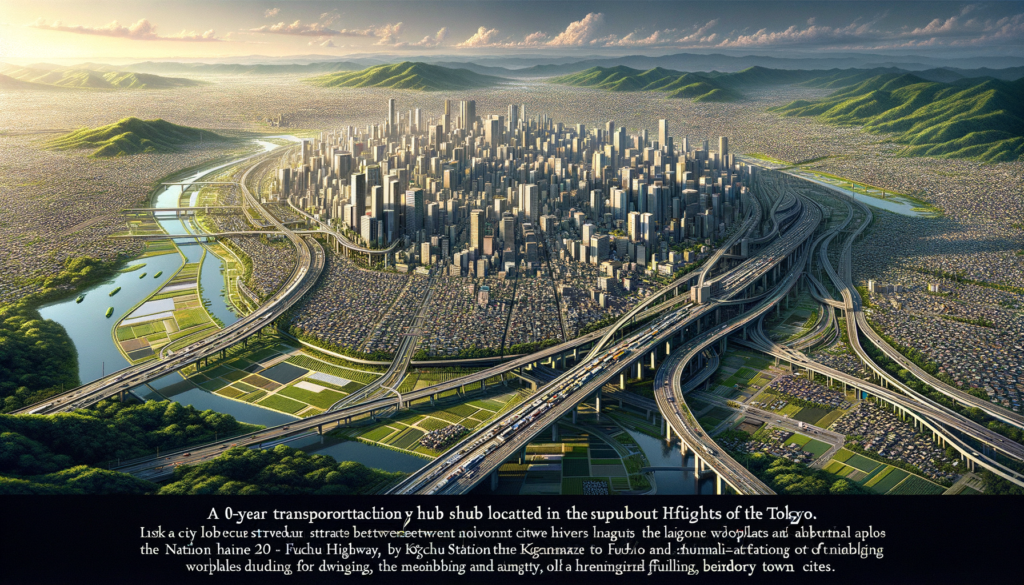
東京都府中市

新宿から22km西方、日本橋からは30km西方に位置します。
「府中」とは「国府所在地」を意味する地名で、武蔵国の国府が置かれた地であることから「府中」と呼ばれており、これが市名の由来です。
古代の遺跡が多く、また645年の大化の改新後に武蔵国の国府が置かれるなど、古くから政治や経済と文化の中心地として栄えており、江戸時代は甲州街道の宿場の中でも大きな「府中宿」があった。鎌倉時代にも要衝地域となっており、戦後も多摩地域の主要都市として行政機関・病院等の公共機関が数多く集積します。
交通網としては、現在でも東京都区部近郊の交通の重要な拠点として東西南北(区部・東京郊外・神奈川県および埼玉県)を結んでいます。これは国府設置以来中心地にある大國魂神社を基点に発達していったことが影響しています。
なお、京王線府中駅からJR線府中本町駅までのエリアは、東京多摩地域有数規模の繁華街・市街地が形成されています。国道20号線・府中街道・小金井街道に挟まれる様に街が広がっています。
また、一級河川や雑木林や山があるなど、市域のほとんどが居住に適した平地でありながら、河川に野山、数多くの広い公園や農地緑地など、多くの緑を有しています。
夜間人口と昼間人口がほぼ同じなのは、近隣のベッドタウン都市とは違い職住近接した生活環境である事が理由である。歴史がある街の為、地元志向が都心から同距離の国分寺や調布などに比べ高い傾向があり、これらから市民の満足度が高く、市のアンケートでもほぼ全市民が将来も住み続けたい街として回答しており、「生活実感値」満足度都内第1位とされる事もあります。
Located 22 kilometers west of Shinjuku and 30 kilometers west of Nihonbashi, Fuchu is a place name that means "the location of the provincial capital," named after being the site of the provincial capital of Musashi Province. It has been a center of politics, economy, and culture since ancient times, with numerous ancient ruins and serving as the provincial capital of Musashi Province after the Taika Reforms in 645. During the Edo period, Fuchu prospered as a major post town along the Koshu Kaido highway. It was also a strategic area in the Kamakura period and continues to be a major city in the Tama region post-war, with a concentration of government institutions, hospitals, and other public facilities.
As a key transportation hub in the Tokyo metropolitan area, Fuchu connects the east, west, north, and south (including the Tokyo metropolitan area, Tokyo suburbs, Kanagawa, and Saitama) and has developed around the Dai-koku-jinja Shrine, which has been the central point since the establishment of the provincial capital.
The area from Keio Line Fuchu Station to JR Line Fuchu-Honmachi Station forms one of the largest commercial and urban areas in the Tokyo Tama region. The city spreads out between National Route 20, Fuchu-dori, and Koganei-dori.
Despite being mostly flat and suitable for residential living, Fuchu has a significant amount of greenery, including primary rivers, mixed forests, and mountains, as well as numerous large parks, farmland, and green spaces.
The reason for the nighttime population being almost the same as the daytime population is the proximity of work and residence, unlike neighboring bedroom communities. Due to its historical significance, Fuchu has a strong local orientation compared to neighboring cities like Kokubunji and Chofu, resulting in high citizen satisfaction. In city surveys, almost all residents express a desire to continue living in Fuchu in the future, leading to it being ranked as the city with the highest "quality of life" satisfaction in Tokyo.
新宿西方22公里处,日本桥西方30公里处,是府中市。
“府中”这个地名意为“国府所在地”,因为曾是武藏国的国府所在地,所以被称为“府中”,这也是市名的由来。
府中拥有许多古代遗迹,自645年大化改新后成为武藏国的国府,长期以来一直是政治、经济和文化的中心地,江户时代也有庞大的“府中宿”作为甲州街道的重要驿站。在镰仓时代也是重要的要冲地区,战后成为多摩地区的主要城市,集中了许多行政机构、医院等公共机构。
交通网络方面,府中至今仍是东京都区近郊交通的重要枢纽,连接东西南北(区部、东京郊外、神奈川县和埼玉县)。这是因为自国府设立以来,以大国魂神社为中心发展壮大。
从京王线府中站到JR线府中本町站的区域,形成了东京多摩地区规模颇大的繁华市区。城市被国道20号线、府中街道和小金井街道环绕。
此外,市内大部分地区都是适合居住的平原,但河流、山地、许多广阔的公园和农田绿地等使得市内拥有大量绿地。
夜间人口和白天人口几乎相等,这是因为府中市与周边的卧城市不同,拥有职住相近的生活环境。由于历史悠久,市民对本地的依恋程度比距离相同的国分寺、调布等地更高,市民对居住满意度较高,市政府的调查中几乎所有市民都表示希望将来继续居住在这座城市,因此被认为是“生活体验价值”满意度在东京都内排名第一。
※これらのコラムは弊社作成の情報を元に生成 AI により作成、翻訳されたものです
